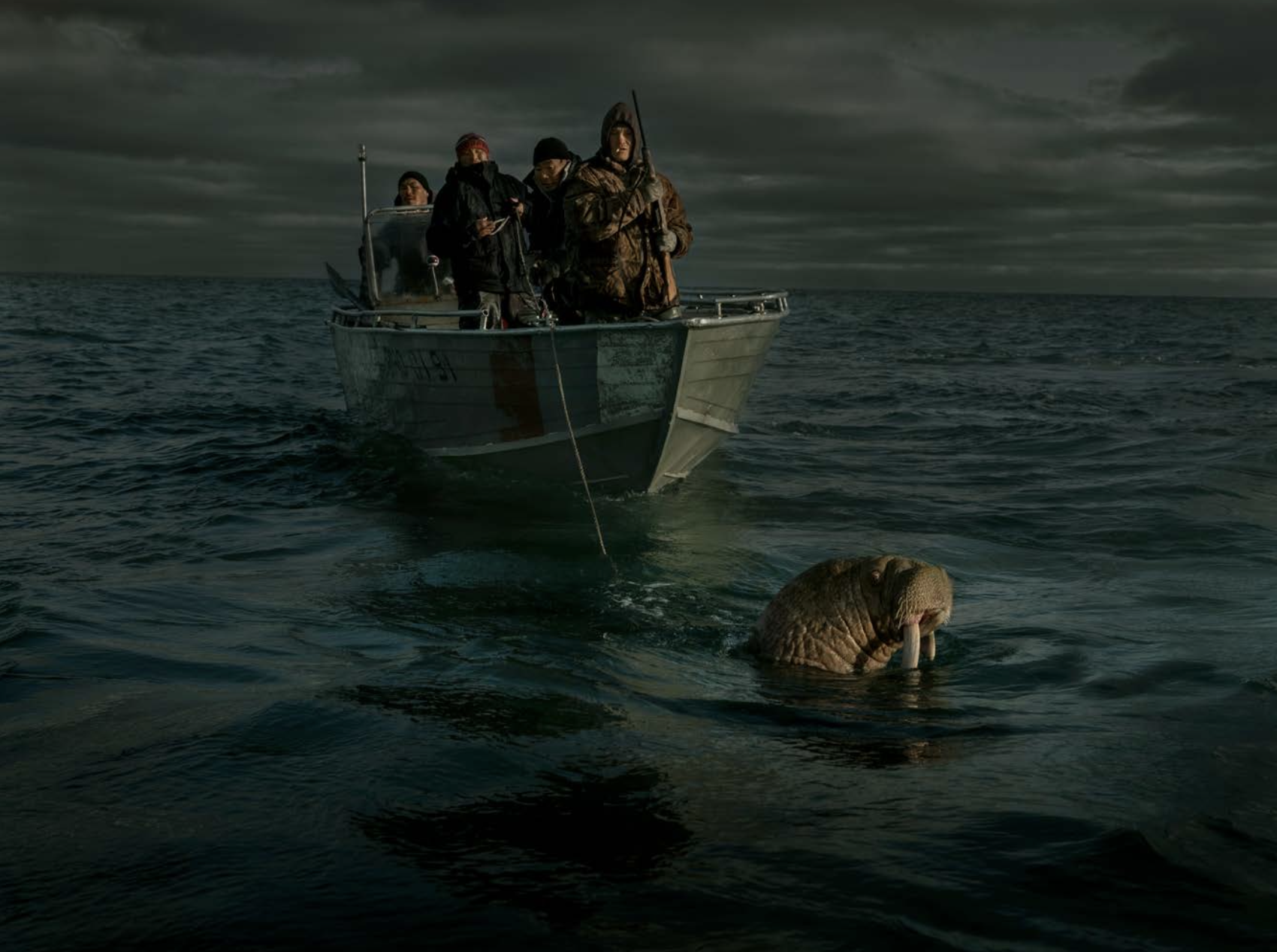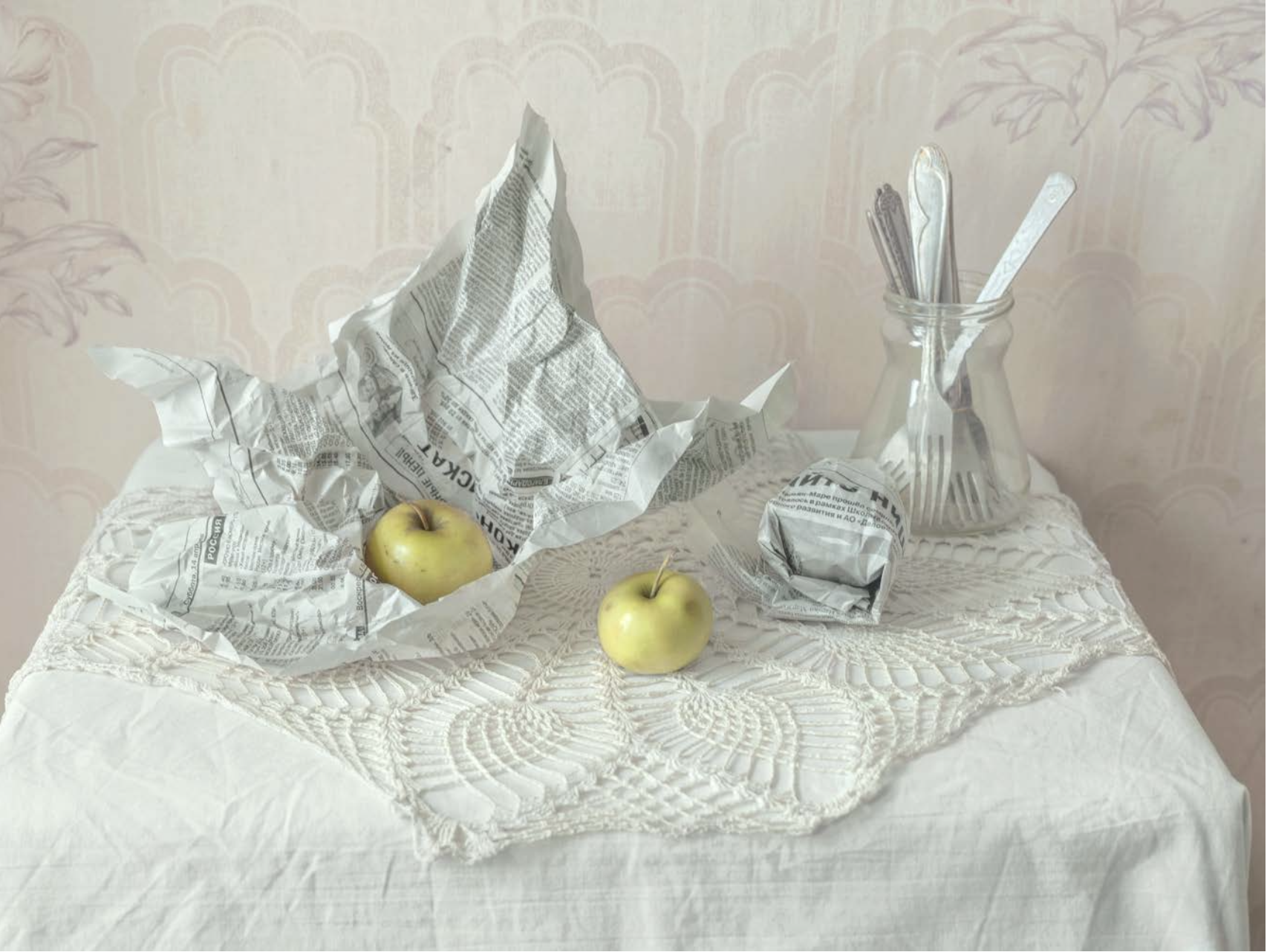Hyperborea: Stories from the Arctic
Hyperborea: Stories from the Arctic, pg. 93 © Evgenia Arbugaeva "Chuckchi people hunt walruses only when they are in the water. They follow international quotas given every year to the Indigenous communities."
Written by Michael Galati
It is counterintuitive to find such a strong sense of connection in some of the most disparate and seemingly inhabitable parts of the world. But, career photographer and Oscar-nominated filmmaker Evgenia Arbugaeva does just that in her seminal photography book, Hyperborea: Stories from the Arctic, documenting a decade’s worth of images from her journey through the Siberian Arctic. Based in London, Arbugaeva grew up in the seaport town of Tiksi on the shore of the Laptev Sea in the Siberian Arctic and returned to the area not only to document the quiet intensity of life in a region that is at the mercy of its environment in a way most habitable places aren’t, but to invite readers to contemplate the real time threats climate change poses to an area that has existed only far off in imagination for many. Through hyperrealist photography, Arbugaeva challenges her viewers to reframe their idea of connection as a means of relation and invites us to reconsider how changing climates manifest in regions far away in our collective minds.
Hyperborea: Stories from the Arctic, pg. 57 © Evgenia Arbugaeva "Newspapers protect apples from frostbite. They also serve well as an insole for wool boots on especially cold days."
Throughout her journey, Arbugaeva’s photographic eye is careful to capture what urban and suburban life take for granted. Some images capture premises that underlie the exigency of modern life such as the idea that indefinite growth and expansion is inevitable and a morally good thing. Other images, such as the one above, however, remind us that such a premise has devastating ecological consequences and precludes us from appreciating what we already have.
When Arbugaeva was traveling to Kanin Nos, a town on the Kanin Peninsula in the west of the Siberian Arctic, she asked the only two people living in the town, Evgenia and her boyfriend Ivan, if they’d like her to bring anything. They requested fresh fruit, a treat in the cold desert of the Arctic. To protect them from frostbite, Arbugaeva says the couple “carefully wrap[ped] them one by one in newspaper as if they were made of crystal.” A fruit that is often figured in popular culture as a catalyst of betrayal or humanity’s downfall is treated as a delicacy in a region inaccessible to most of the world. The exactitude of the image, the sharp wrinkles of the newspaper that contrast the roundness of the apples, and the general monochromatic colors save for the apples, both exalt the apples as treasure and suspend them in anticipation, as if something unforeseen or unfelt will wither them away.
Hyperborea: Stories from the Arctic, pg. 74 © Evgenia Arbugaeva "It was quiet in this dark room. Until suddenly, the doors in the corridor slammed, and I thought I heard someone's footsteps..."
Throughout Hyperborea, Arbugaeva’s eye is drawn particularly to temporality and its relationship to light. This relation comes to the fore in her exploration of Dikson, a town in the north of the Siberian Arctic that was once a hub for academics and professionals and is now abandoned. Polar bears leave their tracks in the snow on long-forgotten streets. In a town occupied only by natural life, it’s notable that the eponymous aurora borealis brings an almost supernatural life to the former commercial town. Its moss green and aqua blue hues cast shadows over an already-dark town, making the darkness deeper and the contrasting light livelier. In doing so, Dikson appears lost in time and Arbugaeva’s images turn realism into surrealism, exaggerating the absence of human life and abstracting the town from temporal placement. In a way, the solitude of the town emphasizes its place in ecological time: a town untouched by modernity, unconstrained by human hands for almost 30 years, where nature reigns over what humanity has left behind, as if the patterns of the weather move time. As the borealis fades, the town slips into oblivion, to be left for nature’s cycle.
Hyperborea: Stories from the Arctic, pg. 63 © Evgenia Arbugaeva "Quiet day. Evgenia reads and keeps warm by the handmade electric heater."
Despite the practical and temporal remoteness of these communities, Arbugaeva makes it a point to capture the connection the people of the towns have to each other and to nature. In doing so, Arbugaeva seeks to redefine modernity’s concept of social interpersonal connection to one that is more ingrained into the day-to-day rituals of being alive. While in Kanin Nos, Arbugaeva spoke to Evgenia and Ivan about their daily lives, which consisted of them completing numerous domestic tasks, going to the ocean to observe the ice and measure the water’s salinity, and playing with their dog, Dragon. In another town in the west, Khodovarikha, Arbugaeva speaks to the town’s chief meteorologist, Slava, who records the temperature of the precipitation and measures the shape of the clouds every three hours to report to a person in another remote office he’s never met. Arbugaeva notes the melancholy she feels from the short and monotonous days, only made worse by the biting cold of the snow and wind. Slava tells her that her melancholy is a result of expectations: let go of them and life is much better. It’s not that the people living in these communities lament the remoteness or the monotony. Rather, it’s the opposite: they live in the peace of their days, walk with joy, and exist fully and consciously in the present.
The majority of Arbugaeva’s pictures are either of a singular person, inanimate objects, or natural phenomena. But a sense of wholeness, belonging, and peace permeates even the most solitary of her pictures. In one picture, Arbugaeva captures Evgenia reading a book by herself. In another picture, she captures Slava looking out into the snowy darkness, his eyes as blue as a cloudless sky or a far-off planet. None of these pictures carry a sense of loneliness with them, though–none feel disjointed, disconnected, or outside from one another. This is because Arbugaeva captures the freedom of living without expectation: life outside of time and modernity, one that listens to nature even when silence is all that is heard.
Hyperborea: Stories from the Arctic, pg. 42 © Evgenia Arbugaeva "Slava reminded me of a character from books and dreams. He is an Arctic wolf and the 'Old Man and the Sea.'"
In Hyperborea, Arbugaeva shows her readers a life outside of time, where connection is the way of life and nature is its guide. Arbugaeva documents a culture that exists at the periphery of modernity’s imagination and one whose existence is acutely threatened by the changing of the climate. The book’s realist/surrealist imagery, all at once unimaginably colorful, cryptic, and other-worldly, reflects the cultures’ being both frozen in time and far ahead of others in terms of environmental susceptibility. What Arbugaeva has done with Hyperborea is create a time capsule of a time forgotten and one that future generations will look back on as a warning of impending environmental degradation. Hyperborea is a photographic and activist success.












